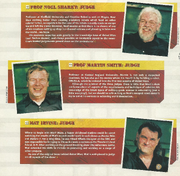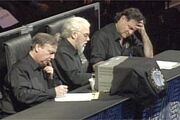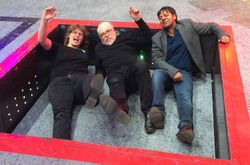Whenever a Robot Wars battle ended with no clear winner, a panel of three Judges would decide on the outcome by scoring each competitor on a set of criteria - style (Series 1-7 and international series only), control, damage and aggression. In total, eight different Judges appeared on the show, all with backgrounds in robotics, engineering, electronics or computer science.
The Judges were required to watch all battles as they were being filmed. They also had the option of reviewing battle footage and/or personally inspecting competitor robots for damage in order to support their decision-making process.
The Judges from the UK Series also appeared on various international versions of the show, as these were usually filmed concurrently in the same arena. In the Dutch and German Robot Wars, they were referred to as the Jury.
List of Judges[]
1994-1997 US Competitions[]
The table below lists publicly-known Judges for the original 1994-1997 US competitions run by Marc Thorpe. Sources available include archived captures of the original US Robot Wars website, along with the official souvenir programme for the 1997 event.
| Name | US Event | Background |
|---|---|---|
| Clayton Bailey[1] | 1995 | Sculptor |
| John Bell[1] | 1995 | Art Director |
| Moira Gunn[1][2] | 1995, 1997 | Ex-NASA scientist, engineer and programmer; biotechnology researcher; host of the public radio show Tech Nation.[3] |
| Jef Raskin[2] | 1997 | Computer scientist; contributor to Wired magazine. |
| Jim Hodgson[2] | 1997 | Brother of Joel Hodgson.[4] |
| Joel Hodgson[2] | 1997 | Writer, comedian and actor; creator of Mystery Science Theater 3000. |
| Michael Rosenthal[2] | 1997 | |
| M.K. Brown[2] | 1997 |
TV Show[]
The table below lists all Judges to appear in the televised show:
| Name | UK Series | Background |
|---|---|---|
| Noel Sharkey | Series 1-10, Extreme 1-2 | Head of Robotics at the University of Sheffield. |
| Eric Dickinson | Series 1-2 | The only British veteran of the original US competition. |
| Adam Harper | Series 1-3 | Then holder of the land speed record for electric vehicles. |
| Martin Smith | Series 3-7, Extreme 1-2 | Head of the UK Cybernautics Society. |
| Myra Wilson | Series 4-5, Extreme 1 | Head of Computer Science at the University of Wales, Aberystwyth. |
| Mat Irvine | Series 5-7, Extreme 1-2 | BBC Technical Consultant and Visual Effects Designer. |
| Sethu Vijayakumar | Series 8-10 | Professor of Robotics at Edinburgh University. |
| Lucy Rogers | Series 8-10 | Doctor of Mechanical Engineering and Author. |

The Judges in Series 6
For Series 5 and Extreme 1, Martin Smith, Myra Wilson and Mat Irvine cycled throughout, with two of the three acting as Judges alongside Noel Sharkey. After this, Wilson left the show, and Irvine, Sharkey and Smith remained in the role until the end of the original show's run. Noel Sharkey, Martin Smith and Mat Irvine also appeared as Judges for all but one series of the US, Dutch and German versions as they all took place during or after the filming for Extreme Series 1, when those three Judges were first put together. The only exception was Dutch Series 1, in which Myra Wilson was a Judge instead of Mat Irvine.
In recognition for creating the first antweight robot, Adam Clark was the sole Judge of the Extreme Series 2 Antweight Championship.
Judges' Decision[]

Martin Smith, Noel Sharkey and Mat Irvine deliberate a Judges' decision
A Judges' decision would be made at the end of a battle if:
- There are a sufficient number of mobile machines when time runs out such that there is no clear winner(s).
- The machines fighting become immobilised at roughly the same time (the judges may call for a rematch in this case).
- There is a rule infraction, for example a health and safety hazard.
- The match must be halted early for any reason (the Judges may call for a rematch or restart in this case).
- It is decided that the House Robots improperly influenced the outcome of the battle.
The four criteria for Judges' decisions during the original run of the series were style, control, damage and aggression. In those series, damage carried the most weight, with aggression being deemed the next most important factor. This was reversed for the reboot, with aggression being the key scoring criteria over damage and control respectively.
- Style refers to how well the robot entertained the audience and demonstrated its capabilities during the battle. Best examples of this include Razer's or Mute's elaborate ways of self-righting. One would lose points for style if it did nothing entertaining during the battle. Style is judged to be the least important of the criteria.
- Control refers to how well the robot was operated during the battle. As well as highlighting good driving skills, it also gives weight to how much control the robot had over the flow of the battle or, as highlighted in the Revival Series, how accurate it is with weapon attacks.[5] Ways to lose points for control include getting pushed around, and poor avoidance of arena hazards. Control is the third most important factor in a Judges' decision.
- Damage refers to the amount of external and/or internal damage inflicted on the other robot as a result of one robot's actions. Notable examples of this include Wild Thing vs Hypno-Disc from Series 4, Firestorm 3 vs Razer from Series 5 and Dominator 2 vs 101, again from Series 4. Throughout the original series, damage was considered to be the most important factor in a Judges' decision, and could outweigh aggression in the event of a closely-fought battle.
- Aggression refers to how aggressive the robot was deemed to have fought during the battle, not necessarily by causing damage. The best example of this in the original series is Storm 2 vs The Grim Reaper from Series 7, where although Storm 2 did not damage The Grim Reaper sufficiently enough to immobilise it, it was continuously on the offensive throughout the entire battle. From Series 8 to 10, this was considered the most influential criteria and officially defined as a robot consistently or 'relentlessly taking the battle to its opponents'.[5][6] Thor's Series 8 Head to Head against Shockwave best exemplifies the latter definition, as its sustained axe attacks significantly outweighed the latter's attempts to ram and push it into Matilda's flywheel.
If there are no clear winners at the end of a battle, the winner of a Judges' decision is the robot which has scored the highest number of points across all categories. This scoring system gives a fair and unbiased chance for every robot - irrespective of size, weight or power - to win.
Weighting of Judges' Decision Criteria[]
Classic Series[]
- DAMAGE. (Weight of 4) 1-5 points x 4 = Score for Damage.
- AGGRESSION. (Weight of 3) 1-5 points x 3 = Score for Aggression.
- CONTROL. (Weight of 2) 1-5 points x 2 = Score for Control.
- STYLE. (Weight of 1) 1-5 points x 1 = Score for Style.
Revival Series[]
NOTE: The scoring criteria and its weighting were revealed publicly in Robot Wars: The Official Handbook
- AGGRESSION. (Weight of 3) 1-5 points x 3 = Score for Aggression.
- DAMAGE. (Weight of 2) 1-5 points x 2 = Score for Damage.
- CONTROL. (Weight of 1) 1-5 points x 1 = Score for Control.
The primary differences in the reboot scoring criteria, compared to the criteria of the classic series, were the shift in Aggression being valued over Damage[7] and the removal of the Style category.
List of Judges' Decisions[]
See: List of judges' decisions in Robot Wars.
Other Responsibilities[]

Lucy Rogers, Noel Sharkey and Sethu Vijayakumar in the pit in Series 8
In Series 8-10, the Judges gained more prominent speaking roles. After certain battles, one Judge would describe the battle they watched, talking about noticeable tactics and/or their opinions on certain competitors' performances. If necessary, they would also justify the outcome of a decision that had recently been made, either on the show or via social media feeds.[8] The selection process for the Grand Final wildcard entry was also initially determined by the Judges during this era, the panel choosing Thor and Apollo in Series 8 and 9 respectively. From Series 9 onwards, head Judge Noel Sharkey was responsible for initiating the countdown timer for immobilised robots, this being achieved by pressing a button on the Judging panel's table.[9]
In Series 10, various mid-battle reactions by the entire Judging panel began to be included in the main televised footage, further increasing their onscreen presence.
In Series 8-10, Dara Ó Briain and Angela Scanlon (Series 9-10) would also interview one Judge in most episodes, discussing developments in robotics, robot combat and technology. Topics of discussion included the NASA Valkyrie project, roboteering communities and communication devices, 'shared autonomy', animatronics, the introduction of lithium polymer (LiPo) batteries and HARDOX steel, and domestic applications of drones and exoskeletons. In Series 10, other industry professionals and roboteers were also featured prominently in these segments, these being Richard Browning and Alex Shakespeare.
1994-1997 US Competitions[]
Though a panel of Judges was also present in the 1994-1997 US competitions, their responsibilities and criteria for scoring battles varied considerably from those in the TV show.
Unlike all other Robot Wars events, the 1994 competition did not enact Judges' decisions if both robots survived to the end of Face-Off (head-to-head) battles, themselves lasting ten minutes. Instead, a draw would be immediately declared, and both competitors would progress automatically into the next round. The practice of disqualifying robots for 'excessive evasion' was also established, to further encourage active combat between the participating machines.[10]
The first application of Judges' decisions and match criteria was in the 1995 event. At the end of a full five-minute battle, an audience vote would first be cast, with a decibel meter being used to record their applause. The loudest applause measured for either of the participating robots would determine the match winner. In the event that the audience vote was too close to determine, the Judges would then make a decision based on points derived from the scoring criteria.[11]
Though the criteria and decision procedures were kept largely intact for the 1996 competition,[12] the 1997 edition saw Judges' decisions taking precedence over audience votes for the first time. Winners would be determined by the Judges based on the existing scoring criteria; in most cases, an audience vote would only be called if the initial decision ended in a 'draw' or was otherwise too close to call.[13]
Criteria[]
The scoring categories for the 1995, 1996 and 1997 competitions were damage, aggression (initially aggressiveness) and control, which were applicable to both Judges' decisions and audience votes. As in the televised Classic series, damage was considered the 'primary criteria' for deciding overall match winners.[11][12][13]
The 'damage' criteria, as written in the 1997 rules, was as follows:
- "Damage is defined as any perceived affect upon or alteration to your opponent's robot during a match ie. scratchs [sic], dents, tears, gouges, holes, lost parts, cuts, etc. Perceived damage may be cosmetic or functional."
- — Official definition of "damage", Fourth Annual Robot Wars (1997) General Rules and Guidelines[13]
Other Responsibilities[]
At various instances throughout the 1994-1997 competitions, the Judges would also be entrusted with responsibilities other than making match decisions. Notably, during the 1995 and 1997 events, they had an active role in withdrawing Blendo from the competition entirely, after the latter threw shrapnel out of the arena boundaries against DooMore and Hercules respectively. Joel Hodgson, who was part of the 1997 panel, also assumed one of the hosting roles for the latter competition.[14][15][16]
A recurring task throughout the 1997 competition was to pause battles in the event that two or more robots became stuck together, in a situation often referred to as a 'deadly embrace'. Upon the battle pausing, Robot Wars crewmembers would manually separate the affected robots, after which the match would continue from the point it was stopped. With pinning also being rendered an illegible method of victory under the 1997 rules, the Judges would also ask the robot initiating the pin to 'release' from its opponent after a certain amount of time.[13]
The 1996 competition marked a rare instance in which the Judges chose to disqualify more than one robot from a given tournament at once. This occurred in the Lightweight Face-Off round between Wonderbug and The Eviscerator, in which both robots were disqualified for lacking sufficient controlled movement throughout the battle.[17][18]
References[]
- ↑ 1.0 1.1 1.2 'ROBOT WARS ® Photos -- 1995 Winners', US Robot Wars website (archived 2 May 1997)
- ↑ 2.0 2.1 2.2 2.3 2.4 2.5 'Credits', 4th Annual Robot Wars (1997) souvenir programme, p.9
- ↑ 'Moira Gunn | University of San Francisco', University of San Francisco website
- ↑ Brad Stone (2003), Gearheads: The Turbulent Rise of Robotic Sports, p.102
- ↑ 5.0 5.1 http://www.robotwars.tv/the-show/
- ↑ Robot Wars: The Official Handbook, p.25
- ↑ ibid.
- ↑ https://twitter.com/NoelSharkey/status/937433847628787713
- ↑ https://mobile.twitter.com/NoelSharkey/status/838468856184176640
- ↑ 'RW94 Rules', Marc Thorpe/Robot Wars, reproduced on the Team Minus Zero website (archived)
- ↑ 11.0 11.1 'ROBOT WARS® 1995 RULES AND GUIDELINES', reproduced on the Team Run Amok website'
- ↑ 12.0 12.1 'THIRD ANNUAL ROBOT WARS 1996 CURRENT RULES AND GUIDELINES', reproduced on the Team Run Amok website
- ↑ 13.0 13.1 13.2 13.3 'General Rules 1997', Official US Robot Wars website (archived 2 May 1997)
- ↑ 'BLENDO', Team Spike website (archived)
- ↑ Gearheads: The Turbulent Rise of Robotic Sports, pp.56-60, pp.106-107
- ↑ 'Robot Wars 1997 bonus video: Blendo withdrawing from the competition', Andrew Lindsey (YouTube), uploaded May 8 2021
- ↑ 'WONDERBUG', Team Spike website (archived)
- ↑ 'Robot Wars 1996: The Eviscerator versus Wonderbug (Lightweight)', Andrew Lindsey (YouTube), uploaded December 17 2018
[]
| ||||||||||||||
